ENTREPRENEURIAL MINDSET: A Study on Female Entrepreneurs in Kenya
VerifiedAdded on 2022/09/15
|9
|3051
|15
Case Study
AI Summary
This case study examines the entrepreneurial mindset of female entrepreneurs in Kenya's solar lighting sector, focusing on the Lighting Africa Kenya program and the Last Mile Entrepreneurs Program (LME). The assignment addresses key issues such as electricity shortfalls, the role of women as both consumers and entrepreneurs, and the innovative business models employed to promote solar energy adoption. It explores the characteristics of successful women entrepreneurs, the importance of financial planning and training, and the challenges related to capital and market access. The case study analyzes the application of entrepreneurial theories, including the Theory of Need of Achievement and Maslow's hierarchy of needs, to understand the motivations and needs of these entrepreneurs. It also delves into the 5Ps of marketing, product mix, and the use of business model innovation and team-building theories. The study highlights the constraints faced by women entrepreneurs, such as financial issues and lack of business skills, and proposes solutions including microloans, group lending, and face-to-face marketing strategies. The assignment concludes by providing a stepwise guideline for female-dominant start-ups, and the seven-stage journey concept that can be used in this case of Kenyan women energy entrepreneurship.
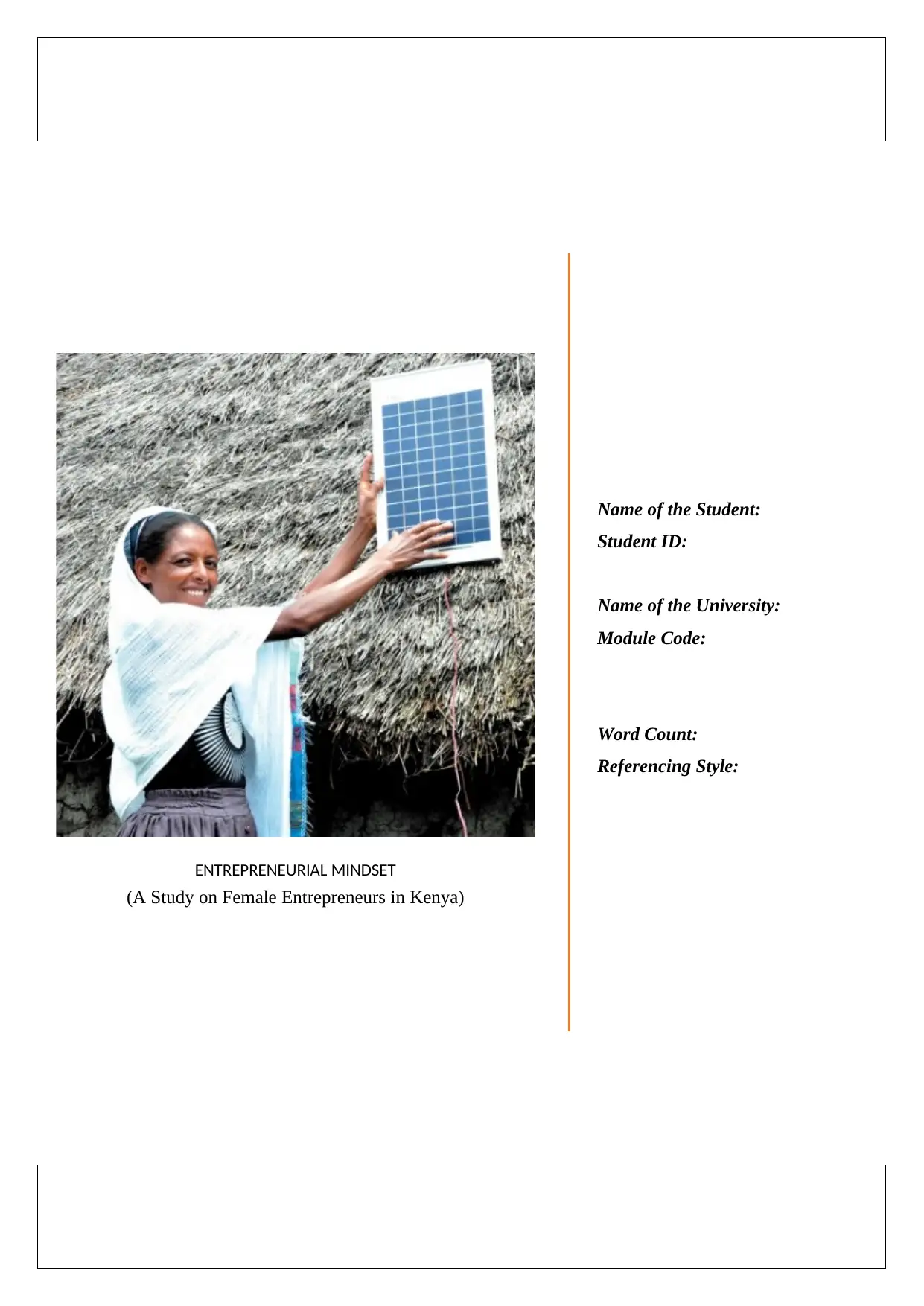
ENTREPRENEURIAL MINDSET
(A Study on Female Entrepreneurs in Kenya)
Name of the Student:
Student ID:
Name of the University:
Module Code:
Word Count:
Referencing Style:
(A Study on Female Entrepreneurs in Kenya)
Name of the Student:
Student ID:
Name of the University:
Module Code:
Word Count:
Referencing Style:
Paraphrase This Document
Need a fresh take? Get an instant paraphrase of this document with our AI Paraphraser
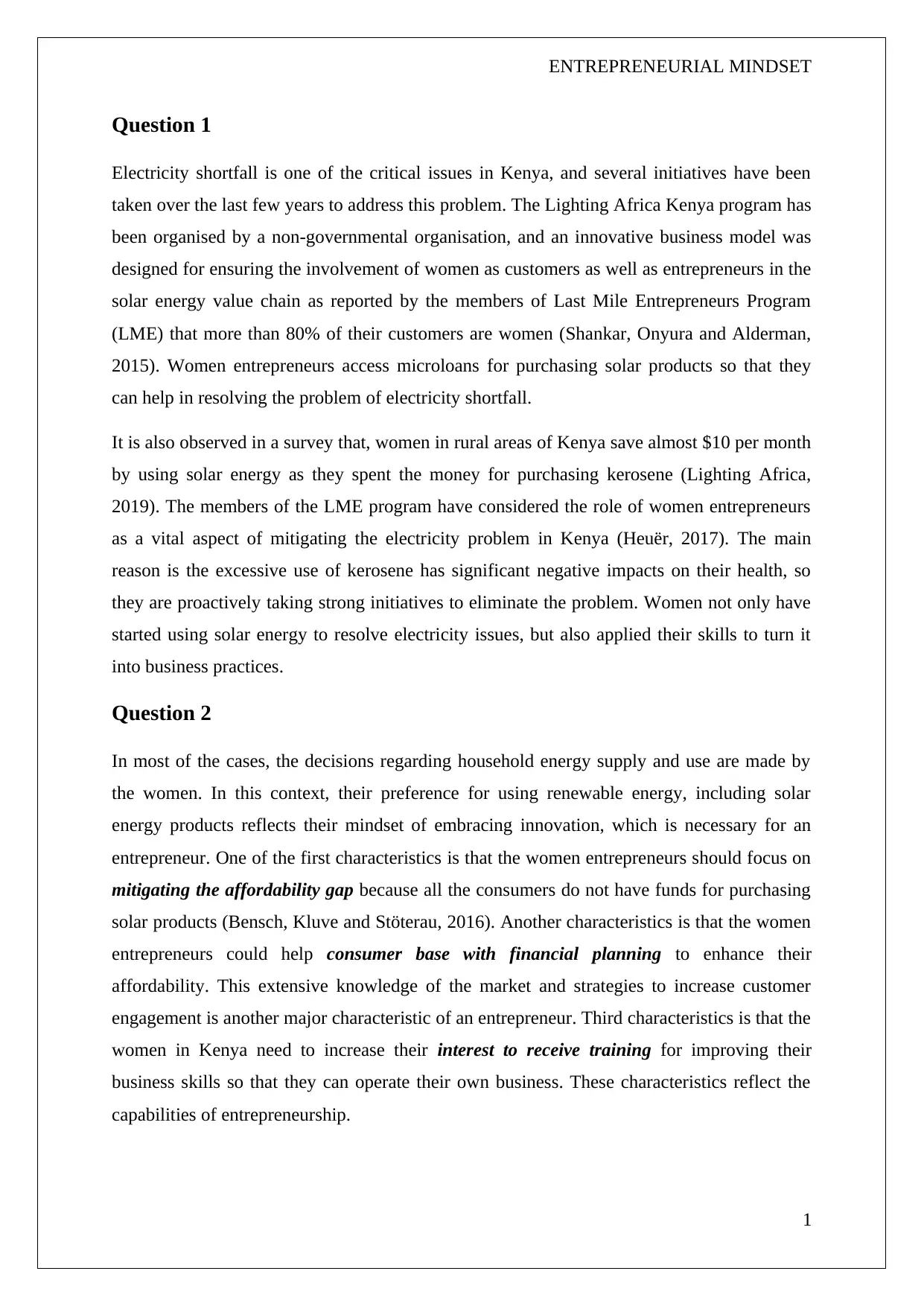
ENTREPRENEURIAL MINDSET
Question 1
Electricity shortfall is one of the critical issues in Kenya, and several initiatives have been
taken over the last few years to address this problem. The Lighting Africa Kenya program has
been organised by a non-governmental organisation, and an innovative business model was
designed for ensuring the involvement of women as customers as well as entrepreneurs in the
solar energy value chain as reported by the members of Last Mile Entrepreneurs Program
(LME) that more than 80% of their customers are women (Shankar, Onyura and Alderman,
2015). Women entrepreneurs access microloans for purchasing solar products so that they
can help in resolving the problem of electricity shortfall.
It is also observed in a survey that, women in rural areas of Kenya save almost $10 per month
by using solar energy as they spent the money for purchasing kerosene (Lighting Africa,
2019). The members of the LME program have considered the role of women entrepreneurs
as a vital aspect of mitigating the electricity problem in Kenya (Heuër, 2017). The main
reason is the excessive use of kerosene has significant negative impacts on their health, so
they are proactively taking strong initiatives to eliminate the problem. Women not only have
started using solar energy to resolve electricity issues, but also applied their skills to turn it
into business practices.
Question 2
In most of the cases, the decisions regarding household energy supply and use are made by
the women. In this context, their preference for using renewable energy, including solar
energy products reflects their mindset of embracing innovation, which is necessary for an
entrepreneur. One of the first characteristics is that the women entrepreneurs should focus on
mitigating the affordability gap because all the consumers do not have funds for purchasing
solar products (Bensch, Kluve and Stöterau, 2016). Another characteristics is that the women
entrepreneurs could help consumer base with financial planning to enhance their
affordability. This extensive knowledge of the market and strategies to increase customer
engagement is another major characteristic of an entrepreneur. Third characteristics is that the
women in Kenya need to increase their interest to receive training for improving their
business skills so that they can operate their own business. These characteristics reflect the
capabilities of entrepreneurship.
1
Question 1
Electricity shortfall is one of the critical issues in Kenya, and several initiatives have been
taken over the last few years to address this problem. The Lighting Africa Kenya program has
been organised by a non-governmental organisation, and an innovative business model was
designed for ensuring the involvement of women as customers as well as entrepreneurs in the
solar energy value chain as reported by the members of Last Mile Entrepreneurs Program
(LME) that more than 80% of their customers are women (Shankar, Onyura and Alderman,
2015). Women entrepreneurs access microloans for purchasing solar products so that they
can help in resolving the problem of electricity shortfall.
It is also observed in a survey that, women in rural areas of Kenya save almost $10 per month
by using solar energy as they spent the money for purchasing kerosene (Lighting Africa,
2019). The members of the LME program have considered the role of women entrepreneurs
as a vital aspect of mitigating the electricity problem in Kenya (Heuër, 2017). The main
reason is the excessive use of kerosene has significant negative impacts on their health, so
they are proactively taking strong initiatives to eliminate the problem. Women not only have
started using solar energy to resolve electricity issues, but also applied their skills to turn it
into business practices.
Question 2
In most of the cases, the decisions regarding household energy supply and use are made by
the women. In this context, their preference for using renewable energy, including solar
energy products reflects their mindset of embracing innovation, which is necessary for an
entrepreneur. One of the first characteristics is that the women entrepreneurs should focus on
mitigating the affordability gap because all the consumers do not have funds for purchasing
solar products (Bensch, Kluve and Stöterau, 2016). Another characteristics is that the women
entrepreneurs could help consumer base with financial planning to enhance their
affordability. This extensive knowledge of the market and strategies to increase customer
engagement is another major characteristic of an entrepreneur. Third characteristics is that the
women in Kenya need to increase their interest to receive training for improving their
business skills so that they can operate their own business. These characteristics reflect the
capabilities of entrepreneurship.
1
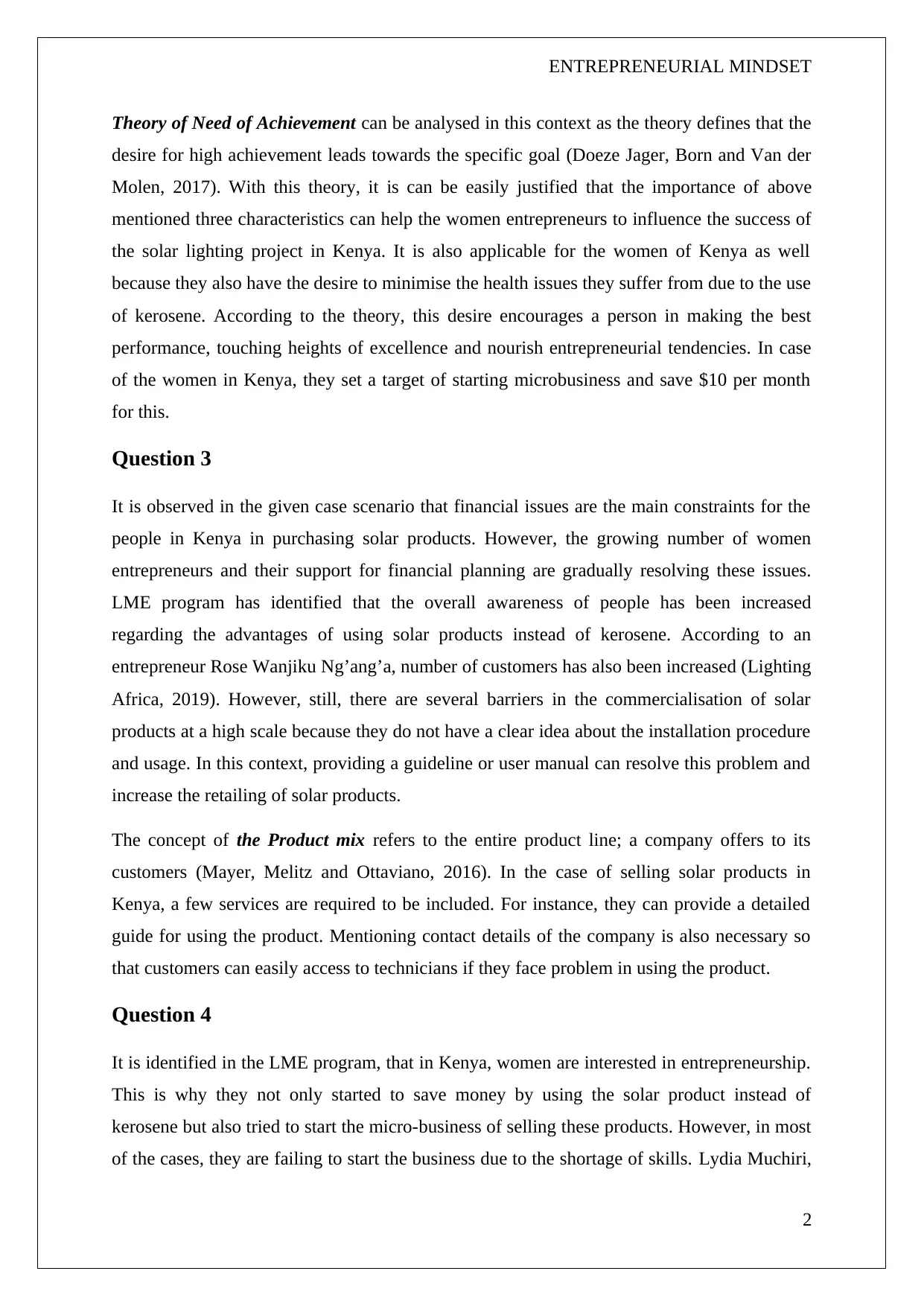
ENTREPRENEURIAL MINDSET
Theory of Need of Achievement can be analysed in this context as the theory defines that the
desire for high achievement leads towards the specific goal (Doeze Jager, Born and Van der
Molen, 2017). With this theory, it is can be easily justified that the importance of above
mentioned three characteristics can help the women entrepreneurs to influence the success of
the solar lighting project in Kenya. It is also applicable for the women of Kenya as well
because they also have the desire to minimise the health issues they suffer from due to the use
of kerosene. According to the theory, this desire encourages a person in making the best
performance, touching heights of excellence and nourish entrepreneurial tendencies. In case
of the women in Kenya, they set a target of starting microbusiness and save $10 per month
for this.
Question 3
It is observed in the given case scenario that financial issues are the main constraints for the
people in Kenya in purchasing solar products. However, the growing number of women
entrepreneurs and their support for financial planning are gradually resolving these issues.
LME program has identified that the overall awareness of people has been increased
regarding the advantages of using solar products instead of kerosene. According to an
entrepreneur Rose Wanjiku Ng’ang’a, number of customers has also been increased (Lighting
Africa, 2019). However, still, there are several barriers in the commercialisation of solar
products at a high scale because they do not have a clear idea about the installation procedure
and usage. In this context, providing a guideline or user manual can resolve this problem and
increase the retailing of solar products.
The concept of the Product mix refers to the entire product line; a company offers to its
customers (Mayer, Melitz and Ottaviano, 2016). In the case of selling solar products in
Kenya, a few services are required to be included. For instance, they can provide a detailed
guide for using the product. Mentioning contact details of the company is also necessary so
that customers can easily access to technicians if they face problem in using the product.
Question 4
It is identified in the LME program, that in Kenya, women are interested in entrepreneurship.
This is why they not only started to save money by using the solar product instead of
kerosene but also tried to start the micro-business of selling these products. However, in most
of the cases, they are failing to start the business due to the shortage of skills. Lydia Muchiri,
2
Theory of Need of Achievement can be analysed in this context as the theory defines that the
desire for high achievement leads towards the specific goal (Doeze Jager, Born and Van der
Molen, 2017). With this theory, it is can be easily justified that the importance of above
mentioned three characteristics can help the women entrepreneurs to influence the success of
the solar lighting project in Kenya. It is also applicable for the women of Kenya as well
because they also have the desire to minimise the health issues they suffer from due to the use
of kerosene. According to the theory, this desire encourages a person in making the best
performance, touching heights of excellence and nourish entrepreneurial tendencies. In case
of the women in Kenya, they set a target of starting microbusiness and save $10 per month
for this.
Question 3
It is observed in the given case scenario that financial issues are the main constraints for the
people in Kenya in purchasing solar products. However, the growing number of women
entrepreneurs and their support for financial planning are gradually resolving these issues.
LME program has identified that the overall awareness of people has been increased
regarding the advantages of using solar products instead of kerosene. According to an
entrepreneur Rose Wanjiku Ng’ang’a, number of customers has also been increased (Lighting
Africa, 2019). However, still, there are several barriers in the commercialisation of solar
products at a high scale because they do not have a clear idea about the installation procedure
and usage. In this context, providing a guideline or user manual can resolve this problem and
increase the retailing of solar products.
The concept of the Product mix refers to the entire product line; a company offers to its
customers (Mayer, Melitz and Ottaviano, 2016). In the case of selling solar products in
Kenya, a few services are required to be included. For instance, they can provide a detailed
guide for using the product. Mentioning contact details of the company is also necessary so
that customers can easily access to technicians if they face problem in using the product.
Question 4
It is identified in the LME program, that in Kenya, women are interested in entrepreneurship.
This is why they not only started to save money by using the solar product instead of
kerosene but also tried to start the micro-business of selling these products. However, in most
of the cases, they are failing to start the business due to the shortage of skills. Lydia Muchiri,
2
⊘ This is a preview!⊘
Do you want full access?
Subscribe today to unlock all pages.

Trusted by 1+ million students worldwide
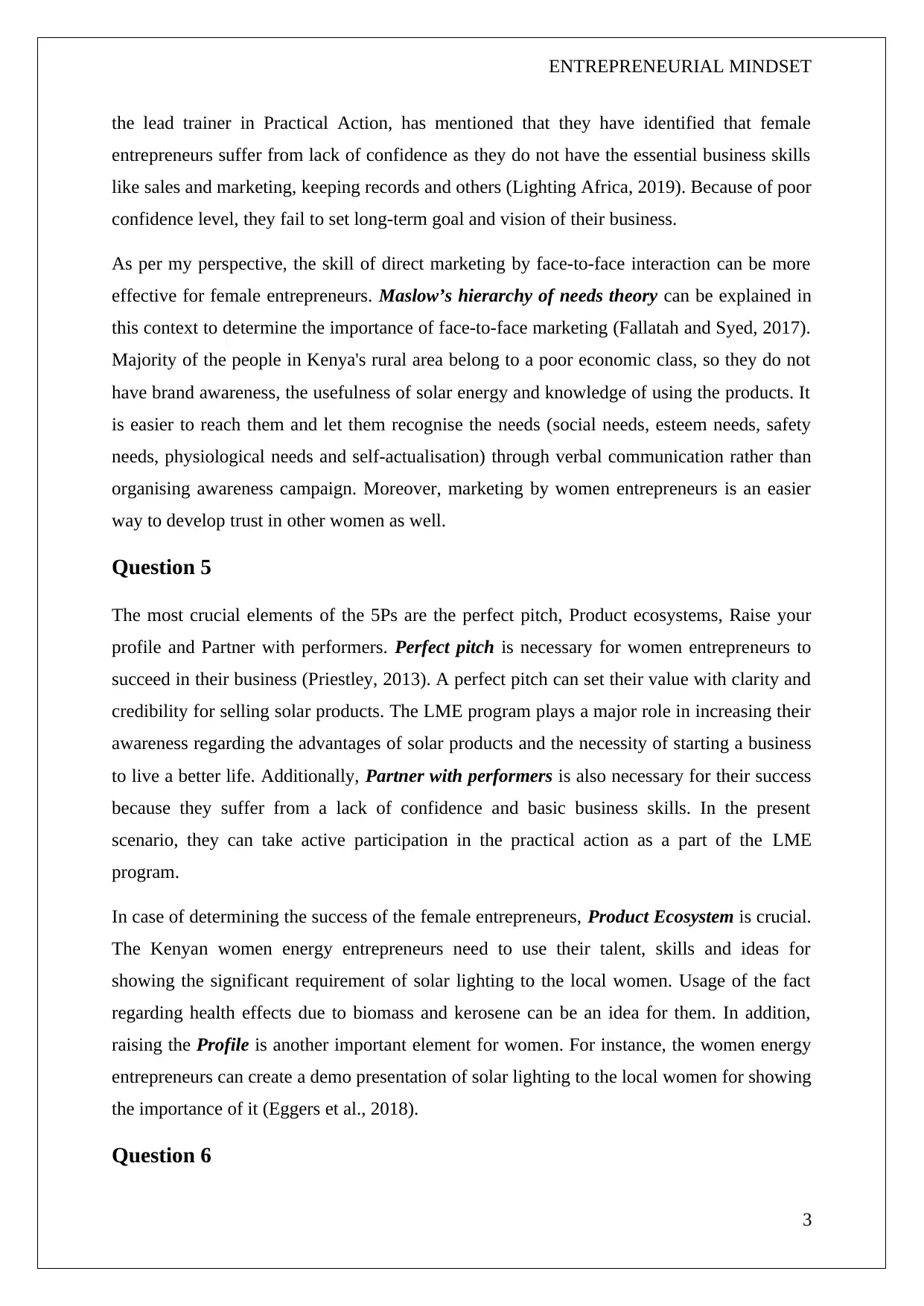
ENTREPRENEURIAL MINDSET
the lead trainer in Practical Action, has mentioned that they have identified that female
entrepreneurs suffer from lack of confidence as they do not have the essential business skills
like sales and marketing, keeping records and others (Lighting Africa, 2019). Because of poor
confidence level, they fail to set long-term goal and vision of their business.
As per my perspective, the skill of direct marketing by face-to-face interaction can be more
effective for female entrepreneurs. Maslow’s hierarchy of needs theory can be explained in
this context to determine the importance of face-to-face marketing (Fallatah and Syed, 2017).
Majority of the people in Kenya's rural area belong to a poor economic class, so they do not
have brand awareness, the usefulness of solar energy and knowledge of using the products. It
is easier to reach them and let them recognise the needs (social needs, esteem needs, safety
needs, physiological needs and self-actualisation) through verbal communication rather than
organising awareness campaign. Moreover, marketing by women entrepreneurs is an easier
way to develop trust in other women as well.
Question 5
The most crucial elements of the 5Ps are the perfect pitch, Product ecosystems, Raise your
profile and Partner with performers. Perfect pitch is necessary for women entrepreneurs to
succeed in their business (Priestley, 2013). A perfect pitch can set their value with clarity and
credibility for selling solar products. The LME program plays a major role in increasing their
awareness regarding the advantages of solar products and the necessity of starting a business
to live a better life. Additionally, Partner with performers is also necessary for their success
because they suffer from a lack of confidence and basic business skills. In the present
scenario, they can take active participation in the practical action as a part of the LME
program.
In case of determining the success of the female entrepreneurs, Product Ecosystem is crucial.
The Kenyan women energy entrepreneurs need to use their talent, skills and ideas for
showing the significant requirement of solar lighting to the local women. Usage of the fact
regarding health effects due to biomass and kerosene can be an idea for them. In addition,
raising the Profile is another important element for women. For instance, the women energy
entrepreneurs can create a demo presentation of solar lighting to the local women for showing
the importance of it (Eggers et al., 2018).
Question 6
3
the lead trainer in Practical Action, has mentioned that they have identified that female
entrepreneurs suffer from lack of confidence as they do not have the essential business skills
like sales and marketing, keeping records and others (Lighting Africa, 2019). Because of poor
confidence level, they fail to set long-term goal and vision of their business.
As per my perspective, the skill of direct marketing by face-to-face interaction can be more
effective for female entrepreneurs. Maslow’s hierarchy of needs theory can be explained in
this context to determine the importance of face-to-face marketing (Fallatah and Syed, 2017).
Majority of the people in Kenya's rural area belong to a poor economic class, so they do not
have brand awareness, the usefulness of solar energy and knowledge of using the products. It
is easier to reach them and let them recognise the needs (social needs, esteem needs, safety
needs, physiological needs and self-actualisation) through verbal communication rather than
organising awareness campaign. Moreover, marketing by women entrepreneurs is an easier
way to develop trust in other women as well.
Question 5
The most crucial elements of the 5Ps are the perfect pitch, Product ecosystems, Raise your
profile and Partner with performers. Perfect pitch is necessary for women entrepreneurs to
succeed in their business (Priestley, 2013). A perfect pitch can set their value with clarity and
credibility for selling solar products. The LME program plays a major role in increasing their
awareness regarding the advantages of solar products and the necessity of starting a business
to live a better life. Additionally, Partner with performers is also necessary for their success
because they suffer from a lack of confidence and basic business skills. In the present
scenario, they can take active participation in the practical action as a part of the LME
program.
In case of determining the success of the female entrepreneurs, Product Ecosystem is crucial.
The Kenyan women energy entrepreneurs need to use their talent, skills and ideas for
showing the significant requirement of solar lighting to the local women. Usage of the fact
regarding health effects due to biomass and kerosene can be an idea for them. In addition,
raising the Profile is another important element for women. For instance, the women energy
entrepreneurs can create a demo presentation of solar lighting to the local women for showing
the importance of it (Eggers et al., 2018).
Question 6
3
Paraphrase This Document
Need a fresh take? Get an instant paraphrase of this document with our AI Paraphraser
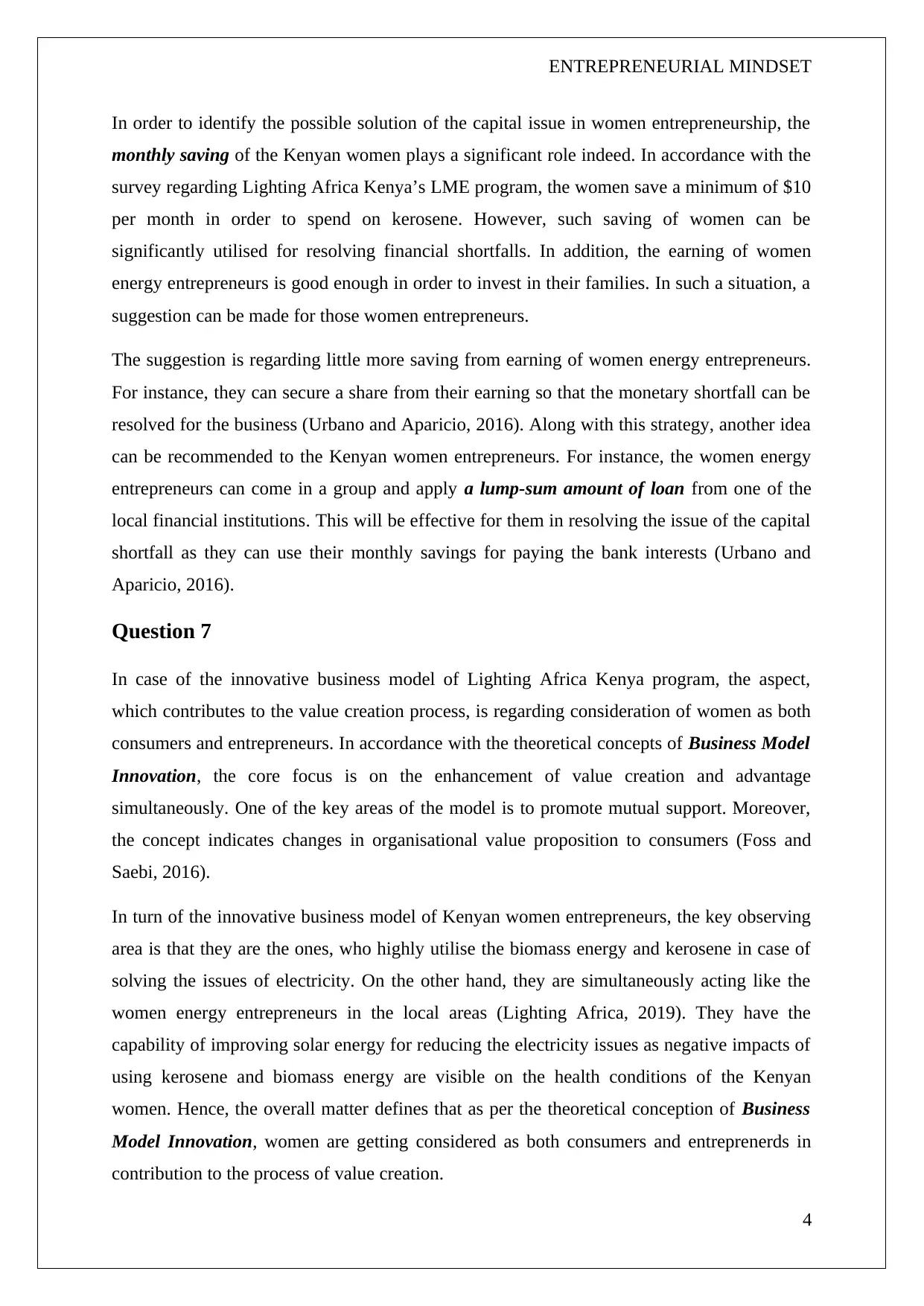
ENTREPRENEURIAL MINDSET
In order to identify the possible solution of the capital issue in women entrepreneurship, the
monthly saving of the Kenyan women plays a significant role indeed. In accordance with the
survey regarding Lighting Africa Kenya’s LME program, the women save a minimum of $10
per month in order to spend on kerosene. However, such saving of women can be
significantly utilised for resolving financial shortfalls. In addition, the earning of women
energy entrepreneurs is good enough in order to invest in their families. In such a situation, a
suggestion can be made for those women entrepreneurs.
The suggestion is regarding little more saving from earning of women energy entrepreneurs.
For instance, they can secure a share from their earning so that the monetary shortfall can be
resolved for the business (Urbano and Aparicio, 2016). Along with this strategy, another idea
can be recommended to the Kenyan women entrepreneurs. For instance, the women energy
entrepreneurs can come in a group and apply a lump-sum amount of loan from one of the
local financial institutions. This will be effective for them in resolving the issue of the capital
shortfall as they can use their monthly savings for paying the bank interests (Urbano and
Aparicio, 2016).
Question 7
In case of the innovative business model of Lighting Africa Kenya program, the aspect,
which contributes to the value creation process, is regarding consideration of women as both
consumers and entrepreneurs. In accordance with the theoretical concepts of Business Model
Innovation, the core focus is on the enhancement of value creation and advantage
simultaneously. One of the key areas of the model is to promote mutual support. Moreover,
the concept indicates changes in organisational value proposition to consumers (Foss and
Saebi, 2016).
In turn of the innovative business model of Kenyan women entrepreneurs, the key observing
area is that they are the ones, who highly utilise the biomass energy and kerosene in case of
solving the issues of electricity. On the other hand, they are simultaneously acting like the
women energy entrepreneurs in the local areas (Lighting Africa, 2019). They have the
capability of improving solar energy for reducing the electricity issues as negative impacts of
using kerosene and biomass energy are visible on the health conditions of the Kenyan
women. Hence, the overall matter defines that as per the theoretical conception of Business
Model Innovation, women are getting considered as both consumers and entreprenerds in
contribution to the process of value creation.
4
In order to identify the possible solution of the capital issue in women entrepreneurship, the
monthly saving of the Kenyan women plays a significant role indeed. In accordance with the
survey regarding Lighting Africa Kenya’s LME program, the women save a minimum of $10
per month in order to spend on kerosene. However, such saving of women can be
significantly utilised for resolving financial shortfalls. In addition, the earning of women
energy entrepreneurs is good enough in order to invest in their families. In such a situation, a
suggestion can be made for those women entrepreneurs.
The suggestion is regarding little more saving from earning of women energy entrepreneurs.
For instance, they can secure a share from their earning so that the monetary shortfall can be
resolved for the business (Urbano and Aparicio, 2016). Along with this strategy, another idea
can be recommended to the Kenyan women entrepreneurs. For instance, the women energy
entrepreneurs can come in a group and apply a lump-sum amount of loan from one of the
local financial institutions. This will be effective for them in resolving the issue of the capital
shortfall as they can use their monthly savings for paying the bank interests (Urbano and
Aparicio, 2016).
Question 7
In case of the innovative business model of Lighting Africa Kenya program, the aspect,
which contributes to the value creation process, is regarding consideration of women as both
consumers and entrepreneurs. In accordance with the theoretical concepts of Business Model
Innovation, the core focus is on the enhancement of value creation and advantage
simultaneously. One of the key areas of the model is to promote mutual support. Moreover,
the concept indicates changes in organisational value proposition to consumers (Foss and
Saebi, 2016).
In turn of the innovative business model of Kenyan women entrepreneurs, the key observing
area is that they are the ones, who highly utilise the biomass energy and kerosene in case of
solving the issues of electricity. On the other hand, they are simultaneously acting like the
women energy entrepreneurs in the local areas (Lighting Africa, 2019). They have the
capability of improving solar energy for reducing the electricity issues as negative impacts of
using kerosene and biomass energy are visible on the health conditions of the Kenyan
women. Hence, the overall matter defines that as per the theoretical conception of Business
Model Innovation, women are getting considered as both consumers and entreprenerds in
contribution to the process of value creation.
4
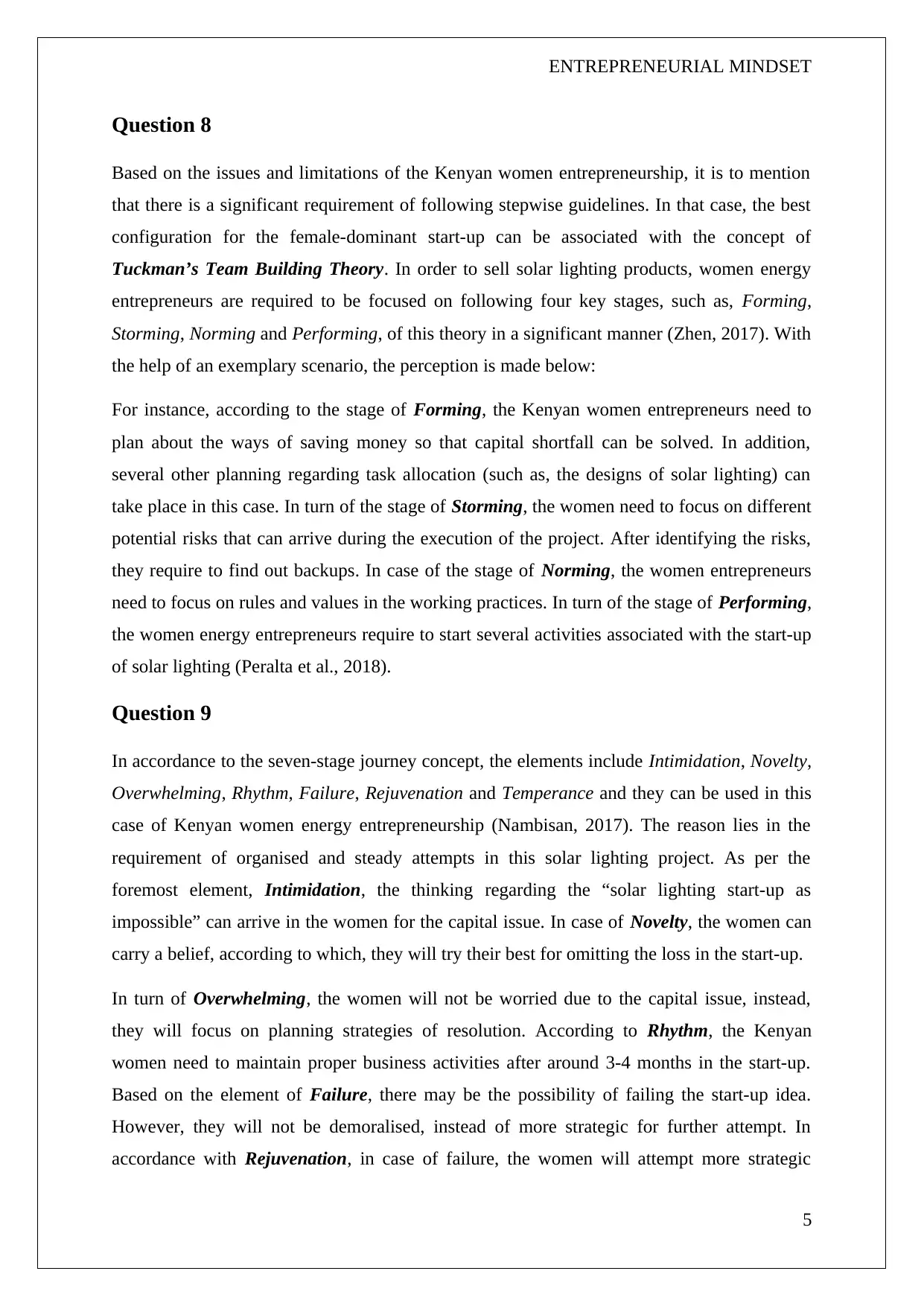
ENTREPRENEURIAL MINDSET
Question 8
Based on the issues and limitations of the Kenyan women entrepreneurship, it is to mention
that there is a significant requirement of following stepwise guidelines. In that case, the best
configuration for the female-dominant start-up can be associated with the concept of
Tuckman’s Team Building Theory. In order to sell solar lighting products, women energy
entrepreneurs are required to be focused on following four key stages, such as, Forming,
Storming, Norming and Performing, of this theory in a significant manner (Zhen, 2017). With
the help of an exemplary scenario, the perception is made below:
For instance, according to the stage of Forming, the Kenyan women entrepreneurs need to
plan about the ways of saving money so that capital shortfall can be solved. In addition,
several other planning regarding task allocation (such as, the designs of solar lighting) can
take place in this case. In turn of the stage of Storming, the women need to focus on different
potential risks that can arrive during the execution of the project. After identifying the risks,
they require to find out backups. In case of the stage of Norming, the women entrepreneurs
need to focus on rules and values in the working practices. In turn of the stage of Performing,
the women energy entrepreneurs require to start several activities associated with the start-up
of solar lighting (Peralta et al., 2018).
Question 9
In accordance to the seven-stage journey concept, the elements include Intimidation, Novelty,
Overwhelming, Rhythm, Failure, Rejuvenation and Temperance and they can be used in this
case of Kenyan women energy entrepreneurship (Nambisan, 2017). The reason lies in the
requirement of organised and steady attempts in this solar lighting project. As per the
foremost element, Intimidation, the thinking regarding the “solar lighting start-up as
impossible” can arrive in the women for the capital issue. In case of Novelty, the women can
carry a belief, according to which, they will try their best for omitting the loss in the start-up.
In turn of Overwhelming, the women will not be worried due to the capital issue, instead,
they will focus on planning strategies of resolution. According to Rhythm, the Kenyan
women need to maintain proper business activities after around 3-4 months in the start-up.
Based on the element of Failure, there may be the possibility of failing the start-up idea.
However, they will not be demoralised, instead of more strategic for further attempt. In
accordance with Rejuvenation, in case of failure, the women will attempt more strategic
5
Question 8
Based on the issues and limitations of the Kenyan women entrepreneurship, it is to mention
that there is a significant requirement of following stepwise guidelines. In that case, the best
configuration for the female-dominant start-up can be associated with the concept of
Tuckman’s Team Building Theory. In order to sell solar lighting products, women energy
entrepreneurs are required to be focused on following four key stages, such as, Forming,
Storming, Norming and Performing, of this theory in a significant manner (Zhen, 2017). With
the help of an exemplary scenario, the perception is made below:
For instance, according to the stage of Forming, the Kenyan women entrepreneurs need to
plan about the ways of saving money so that capital shortfall can be solved. In addition,
several other planning regarding task allocation (such as, the designs of solar lighting) can
take place in this case. In turn of the stage of Storming, the women need to focus on different
potential risks that can arrive during the execution of the project. After identifying the risks,
they require to find out backups. In case of the stage of Norming, the women entrepreneurs
need to focus on rules and values in the working practices. In turn of the stage of Performing,
the women energy entrepreneurs require to start several activities associated with the start-up
of solar lighting (Peralta et al., 2018).
Question 9
In accordance to the seven-stage journey concept, the elements include Intimidation, Novelty,
Overwhelming, Rhythm, Failure, Rejuvenation and Temperance and they can be used in this
case of Kenyan women energy entrepreneurship (Nambisan, 2017). The reason lies in the
requirement of organised and steady attempts in this solar lighting project. As per the
foremost element, Intimidation, the thinking regarding the “solar lighting start-up as
impossible” can arrive in the women for the capital issue. In case of Novelty, the women can
carry a belief, according to which, they will try their best for omitting the loss in the start-up.
In turn of Overwhelming, the women will not be worried due to the capital issue, instead,
they will focus on planning strategies of resolution. According to Rhythm, the Kenyan
women need to maintain proper business activities after around 3-4 months in the start-up.
Based on the element of Failure, there may be the possibility of failing the start-up idea.
However, they will not be demoralised, instead of more strategic for further attempt. In
accordance with Rejuvenation, in case of failure, the women will attempt more strategic
5
⊘ This is a preview!⊘
Do you want full access?
Subscribe today to unlock all pages.

Trusted by 1+ million students worldwide
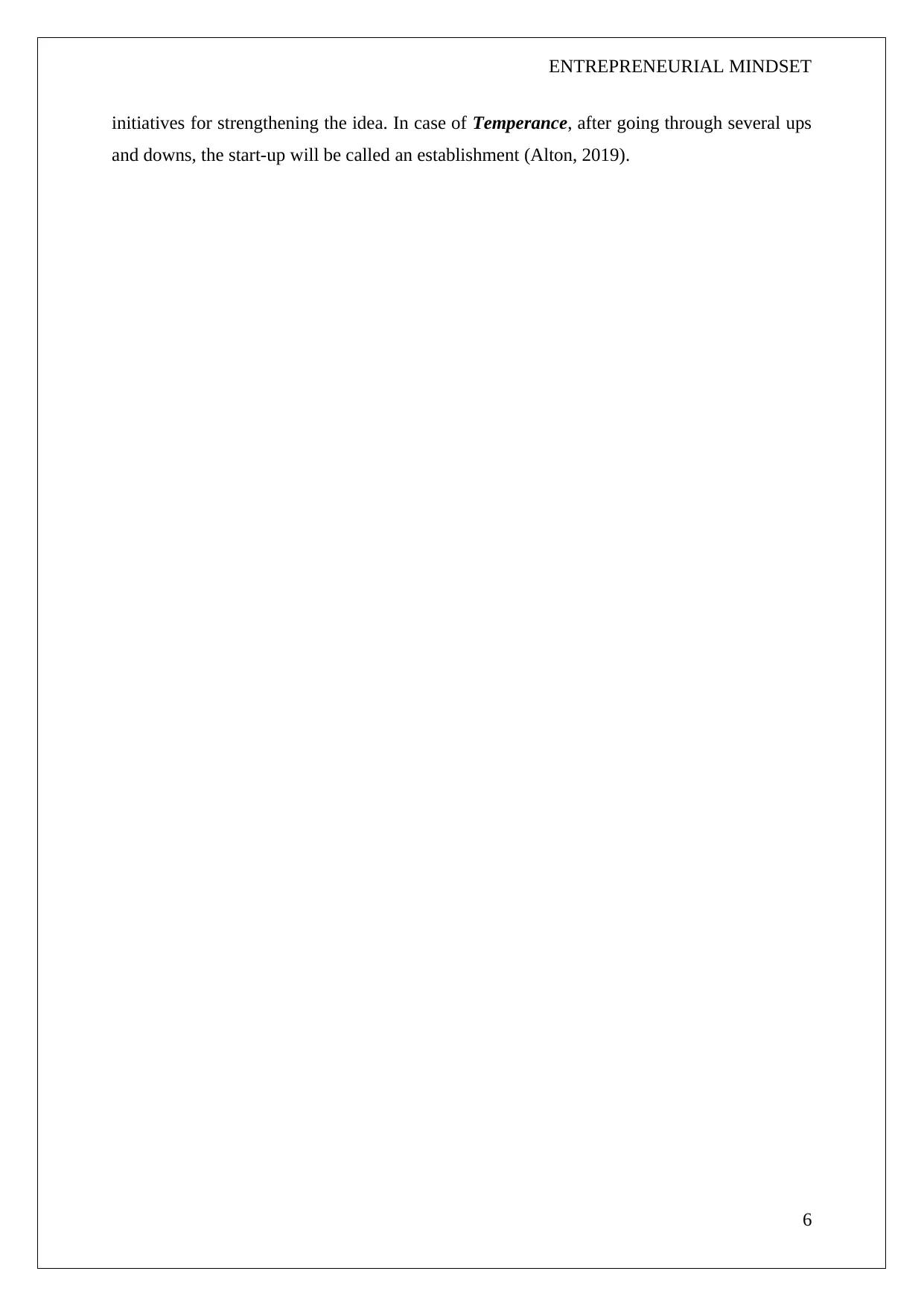
ENTREPRENEURIAL MINDSET
initiatives for strengthening the idea. In case of Temperance, after going through several ups
and downs, the start-up will be called an establishment (Alton, 2019).
6
initiatives for strengthening the idea. In case of Temperance, after going through several ups
and downs, the start-up will be called an establishment (Alton, 2019).
6
Paraphrase This Document
Need a fresh take? Get an instant paraphrase of this document with our AI Paraphraser
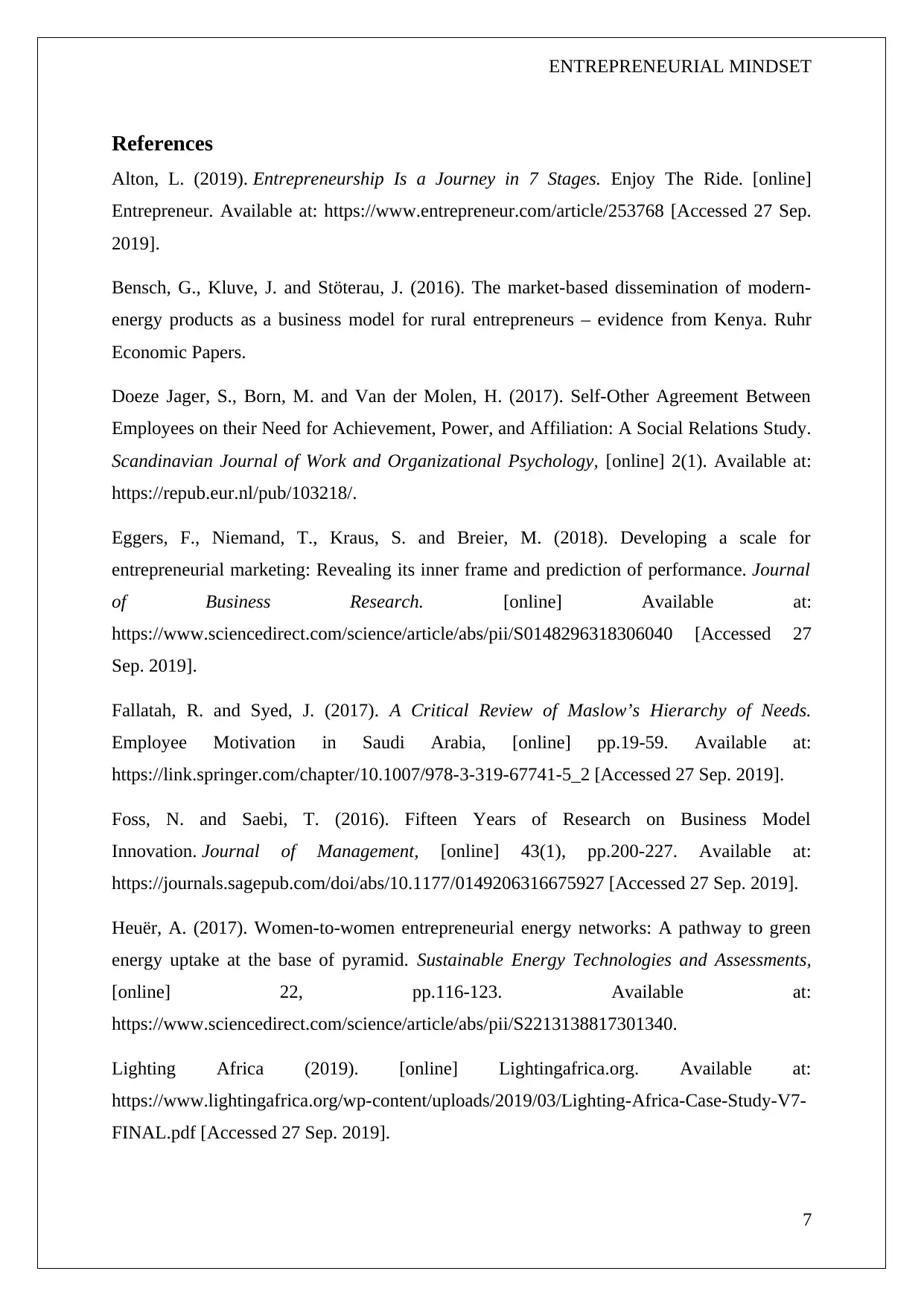
ENTREPRENEURIAL MINDSET
References
Alton, L. (2019). Entrepreneurship Is a Journey in 7 Stages. Enjoy The Ride. [online]
Entrepreneur. Available at: https://www.entrepreneur.com/article/253768 [Accessed 27 Sep.
2019].
Bensch, G., Kluve, J. and Stöterau, J. (2016). The market-based dissemination of modern-
energy products as a business model for rural entrepreneurs – evidence from Kenya. Ruhr
Economic Papers.
Doeze Jager, S., Born, M. and Van der Molen, H. (2017). Self-Other Agreement Between
Employees on their Need for Achievement, Power, and Affiliation: A Social Relations Study.
Scandinavian Journal of Work and Organizational Psychology, [online] 2(1). Available at:
https://repub.eur.nl/pub/103218/.
Eggers, F., Niemand, T., Kraus, S. and Breier, M. (2018). Developing a scale for
entrepreneurial marketing: Revealing its inner frame and prediction of performance. Journal
of Business Research. [online] Available at:
https://www.sciencedirect.com/science/article/abs/pii/S0148296318306040 [Accessed 27
Sep. 2019].
Fallatah, R. and Syed, J. (2017). A Critical Review of Maslow’s Hierarchy of Needs.
Employee Motivation in Saudi Arabia, [online] pp.19-59. Available at:
https://link.springer.com/chapter/10.1007/978-3-319-67741-5_2 [Accessed 27 Sep. 2019].
Foss, N. and Saebi, T. (2016). Fifteen Years of Research on Business Model
Innovation. Journal of Management, [online] 43(1), pp.200-227. Available at:
https://journals.sagepub.com/doi/abs/10.1177/0149206316675927 [Accessed 27 Sep. 2019].
Heuër, A. (2017). Women-to-women entrepreneurial energy networks: A pathway to green
energy uptake at the base of pyramid. Sustainable Energy Technologies and Assessments,
[online] 22, pp.116-123. Available at:
https://www.sciencedirect.com/science/article/abs/pii/S2213138817301340.
Lighting Africa (2019). [online] Lightingafrica.org. Available at:
https://www.lightingafrica.org/wp-content/uploads/2019/03/Lighting-Africa-Case-Study-V7-
FINAL.pdf [Accessed 27 Sep. 2019].
7
References
Alton, L. (2019). Entrepreneurship Is a Journey in 7 Stages. Enjoy The Ride. [online]
Entrepreneur. Available at: https://www.entrepreneur.com/article/253768 [Accessed 27 Sep.
2019].
Bensch, G., Kluve, J. and Stöterau, J. (2016). The market-based dissemination of modern-
energy products as a business model for rural entrepreneurs – evidence from Kenya. Ruhr
Economic Papers.
Doeze Jager, S., Born, M. and Van der Molen, H. (2017). Self-Other Agreement Between
Employees on their Need for Achievement, Power, and Affiliation: A Social Relations Study.
Scandinavian Journal of Work and Organizational Psychology, [online] 2(1). Available at:
https://repub.eur.nl/pub/103218/.
Eggers, F., Niemand, T., Kraus, S. and Breier, M. (2018). Developing a scale for
entrepreneurial marketing: Revealing its inner frame and prediction of performance. Journal
of Business Research. [online] Available at:
https://www.sciencedirect.com/science/article/abs/pii/S0148296318306040 [Accessed 27
Sep. 2019].
Fallatah, R. and Syed, J. (2017). A Critical Review of Maslow’s Hierarchy of Needs.
Employee Motivation in Saudi Arabia, [online] pp.19-59. Available at:
https://link.springer.com/chapter/10.1007/978-3-319-67741-5_2 [Accessed 27 Sep. 2019].
Foss, N. and Saebi, T. (2016). Fifteen Years of Research on Business Model
Innovation. Journal of Management, [online] 43(1), pp.200-227. Available at:
https://journals.sagepub.com/doi/abs/10.1177/0149206316675927 [Accessed 27 Sep. 2019].
Heuër, A. (2017). Women-to-women entrepreneurial energy networks: A pathway to green
energy uptake at the base of pyramid. Sustainable Energy Technologies and Assessments,
[online] 22, pp.116-123. Available at:
https://www.sciencedirect.com/science/article/abs/pii/S2213138817301340.
Lighting Africa (2019). [online] Lightingafrica.org. Available at:
https://www.lightingafrica.org/wp-content/uploads/2019/03/Lighting-Africa-Case-Study-V7-
FINAL.pdf [Accessed 27 Sep. 2019].
7
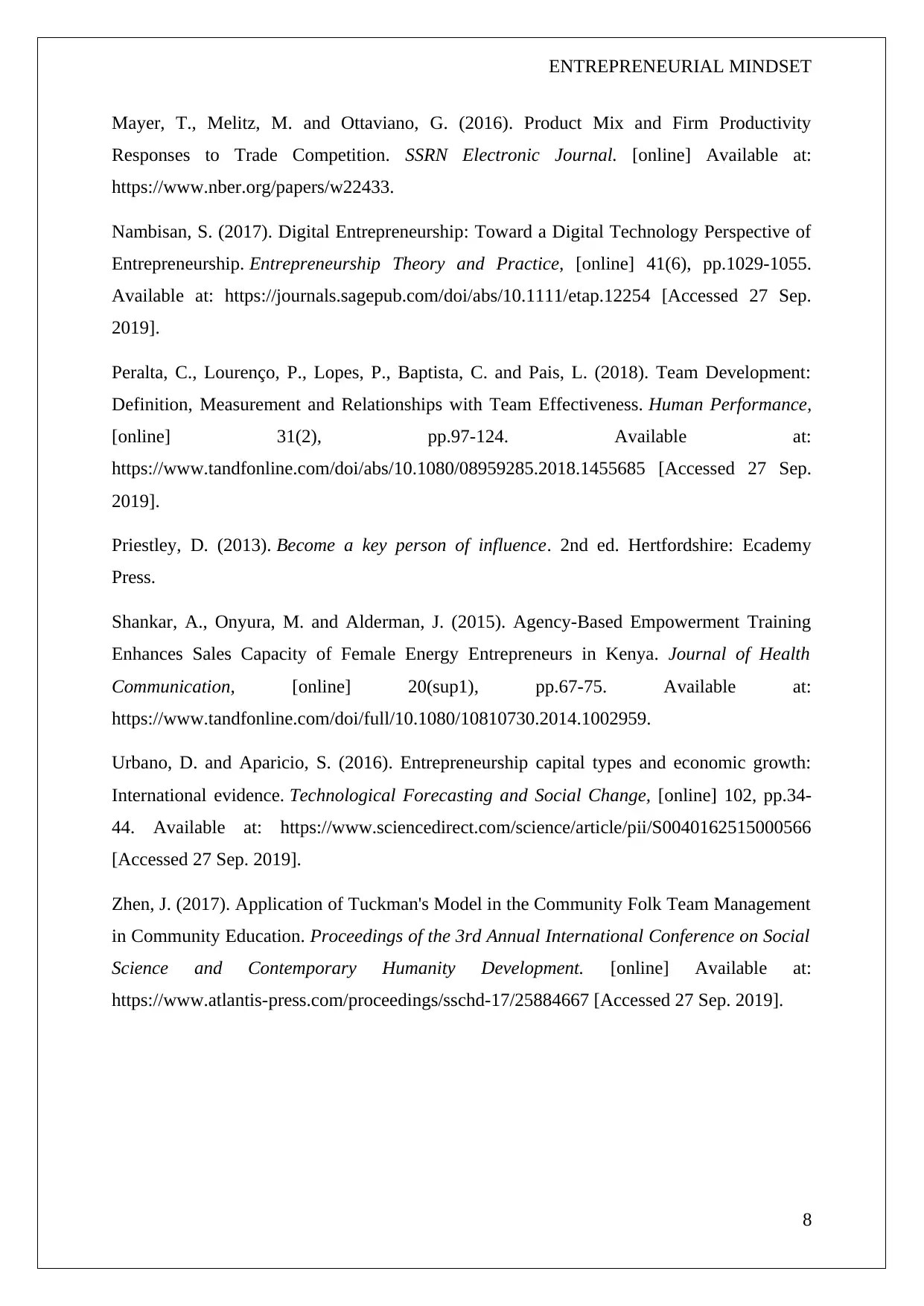
ENTREPRENEURIAL MINDSET
Mayer, T., Melitz, M. and Ottaviano, G. (2016). Product Mix and Firm Productivity
Responses to Trade Competition. SSRN Electronic Journal. [online] Available at:
https://www.nber.org/papers/w22433.
Nambisan, S. (2017). Digital Entrepreneurship: Toward a Digital Technology Perspective of
Entrepreneurship. Entrepreneurship Theory and Practice, [online] 41(6), pp.1029-1055.
Available at: https://journals.sagepub.com/doi/abs/10.1111/etap.12254 [Accessed 27 Sep.
2019].
Peralta, C., Lourenço, P., Lopes, P., Baptista, C. and Pais, L. (2018). Team Development:
Definition, Measurement and Relationships with Team Effectiveness. Human Performance,
[online] 31(2), pp.97-124. Available at:
https://www.tandfonline.com/doi/abs/10.1080/08959285.2018.1455685 [Accessed 27 Sep.
2019].
Priestley, D. (2013). Become a key person of influence. 2nd ed. Hertfordshire: Ecademy
Press.
Shankar, A., Onyura, M. and Alderman, J. (2015). Agency-Based Empowerment Training
Enhances Sales Capacity of Female Energy Entrepreneurs in Kenya. Journal of Health
Communication, [online] 20(sup1), pp.67-75. Available at:
https://www.tandfonline.com/doi/full/10.1080/10810730.2014.1002959.
Urbano, D. and Aparicio, S. (2016). Entrepreneurship capital types and economic growth:
International evidence. Technological Forecasting and Social Change, [online] 102, pp.34-
44. Available at: https://www.sciencedirect.com/science/article/pii/S0040162515000566
[Accessed 27 Sep. 2019].
Zhen, J. (2017). Application of Tuckman's Model in the Community Folk Team Management
in Community Education. Proceedings of the 3rd Annual International Conference on Social
Science and Contemporary Humanity Development. [online] Available at:
https://www.atlantis-press.com/proceedings/sschd-17/25884667 [Accessed 27 Sep. 2019].
8
Mayer, T., Melitz, M. and Ottaviano, G. (2016). Product Mix and Firm Productivity
Responses to Trade Competition. SSRN Electronic Journal. [online] Available at:
https://www.nber.org/papers/w22433.
Nambisan, S. (2017). Digital Entrepreneurship: Toward a Digital Technology Perspective of
Entrepreneurship. Entrepreneurship Theory and Practice, [online] 41(6), pp.1029-1055.
Available at: https://journals.sagepub.com/doi/abs/10.1111/etap.12254 [Accessed 27 Sep.
2019].
Peralta, C., Lourenço, P., Lopes, P., Baptista, C. and Pais, L. (2018). Team Development:
Definition, Measurement and Relationships with Team Effectiveness. Human Performance,
[online] 31(2), pp.97-124. Available at:
https://www.tandfonline.com/doi/abs/10.1080/08959285.2018.1455685 [Accessed 27 Sep.
2019].
Priestley, D. (2013). Become a key person of influence. 2nd ed. Hertfordshire: Ecademy
Press.
Shankar, A., Onyura, M. and Alderman, J. (2015). Agency-Based Empowerment Training
Enhances Sales Capacity of Female Energy Entrepreneurs in Kenya. Journal of Health
Communication, [online] 20(sup1), pp.67-75. Available at:
https://www.tandfonline.com/doi/full/10.1080/10810730.2014.1002959.
Urbano, D. and Aparicio, S. (2016). Entrepreneurship capital types and economic growth:
International evidence. Technological Forecasting and Social Change, [online] 102, pp.34-
44. Available at: https://www.sciencedirect.com/science/article/pii/S0040162515000566
[Accessed 27 Sep. 2019].
Zhen, J. (2017). Application of Tuckman's Model in the Community Folk Team Management
in Community Education. Proceedings of the 3rd Annual International Conference on Social
Science and Contemporary Humanity Development. [online] Available at:
https://www.atlantis-press.com/proceedings/sschd-17/25884667 [Accessed 27 Sep. 2019].
8
⊘ This is a preview!⊘
Do you want full access?
Subscribe today to unlock all pages.

Trusted by 1+ million students worldwide
1 out of 9
Your All-in-One AI-Powered Toolkit for Academic Success.
+13062052269
info@desklib.com
Available 24*7 on WhatsApp / Email
![[object Object]](/_next/static/media/star-bottom.7253800d.svg)
Unlock your academic potential
Copyright © 2020–2025 A2Z Services. All Rights Reserved. Developed and managed by ZUCOL.

